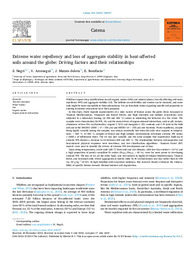Por favor, use este identificador para citar o enlazar este ítem:
https://hdl.handle.net/11000/37773Registro completo de metadatos
| Campo DC | Valor | Lengua/Idioma |
|---|---|---|
| dc.contributor.author | Negri, S. | - |
| dc.contributor.author | Arcenegui, V. | - |
| dc.contributor.author | Mataix-Solera, Jorge | - |
| dc.contributor.author | Bonifacio, E. | - |
| dc.contributor.other | Departamentos de la UMH::Agroquímica y Medio Ambiente | es_ES |
| dc.date.accessioned | 2025-11-03T11:24:23Z | - |
| dc.date.available | 2025-11-03T11:24:23Z | - |
| dc.date.created | 2024-09 | - |
| dc.identifier.citation | CATENA, Volume 244, September 2024, 108257 | es_ES |
| dc.identifier.issn | 1872-6887 | - |
| dc.identifier.issn | 0341-8162 | - |
| dc.identifier.uri | https://hdl.handle.net/11000/37773 | - |
| dc.description.abstract | Wildfires impose deep modifications on soil organic matter (OM) and mineral phases, heavily affecting soil water repellency (WR) and aggregate stability (AS). The fallouts on soil fertility and erosion can be dramatic, and some soils might be more susceptible to these phenomena. Yet, no threshold values regarding specific soil properties or existing terrestrial ecosystems have been proposed. In this study, thirty topsoils representative of a wide variety of biomes across the globe (from Savannah to Tropical, Mediterranean, Temperate and Boreal forests, and High elevation and latitude ecosystems) were subjected to a laboratory heating (at 200 and 300 ◦C) aimed at mimicking the behavior of a fire event. The samples were characterized for WR, AS, and the main drivers of organo-mineral interactions, such as pH, texture, abundance of iron (Fe) oxyhydroxides, organic C (OC) and inorganic C (IC) contents, and C/N ratio in the bulk soil and in the MACRO (2000 > Ø > 250 µm) and MICRO (Ø < 250 µm) size fractions. Water repellency, despite being highly variable among the samples, was always drastically lost when the soils were exposed to temperatures > 200 ◦C. At 200 ◦C, samples of Boreal and High latitude environments developed extreme WR values (>2000 s of infiltration time). The AS was also variable, and the same samples that experienced build-up of extreme WR showed a decrease in AS between 200 and 300 ◦C. The relationships between soil properties and heat-induced physical responses were non-linear, and two classification algorithms − Random Forest (RF) models- were used to identify the drivers of extreme WR development and AS loss. Upon rising temperatures, acidic soils (pH<7) from cold and wet climates, with low clay content (<10 %) and a high proportion of poorly crystalline Fe oxides (FeOXA/FeDCB > 40 %), were far more prone to developing extreme WR. The loss of AS, on the other hand, was not induced in highly-developed Mediterranean, Tropical forest, and Savannah soils, where aggregation is mostly ruled by Fe oxyhydroxides and clay rather than by OM (ca. 50 g kg− 1 of OC). In tight interlink with ecosystem resilience, this research clearly evidenced the vulnerability of specific biomes towards thermal-induced soil degradation. | es_ES |
| dc.format | application/pdf | es_ES |
| dc.format.extent | 13 | es_ES |
| dc.language.iso | eng | es_ES |
| dc.publisher | Elsevier | es_ES |
| dc.rights | info:eu-repo/semantics/openAccess | es_ES |
| dc.rights.uri | http://creativecommons.org/licenses/by-nc-nd/4.0/ | * |
| dc.subject | Thermal treatment | es_ES |
| dc.subject | World biomes | es_ES |
| dc.subject | Fire | es_ES |
| dc.subject | Organic matter | es_ES |
| dc.subject | Organo-mineral interactions | es_ES |
| dc.subject.other | CDU::5 - Ciencias puras y naturales | es_ES |
| dc.title | Extreme water repellency and loss of aggregate stability in heat-affected soils around the globe: Driving factors and their relationships | es_ES |
| dc.type | info:eu-repo/semantics/article | es_ES |
| dc.relation.publisherversion | https://doi.org/10.1016/j.catena.2024.108257 | es_ES |

Ver/Abrir:
Negri et al. CATENA 2024.pdf
2,91 MB
Adobe PDF
Compartir:
 La licencia se describe como: Atribución-NonComercial-NoDerivada 4.0 Internacional.
La licencia se describe como: Atribución-NonComercial-NoDerivada 4.0 Internacional.
.png)